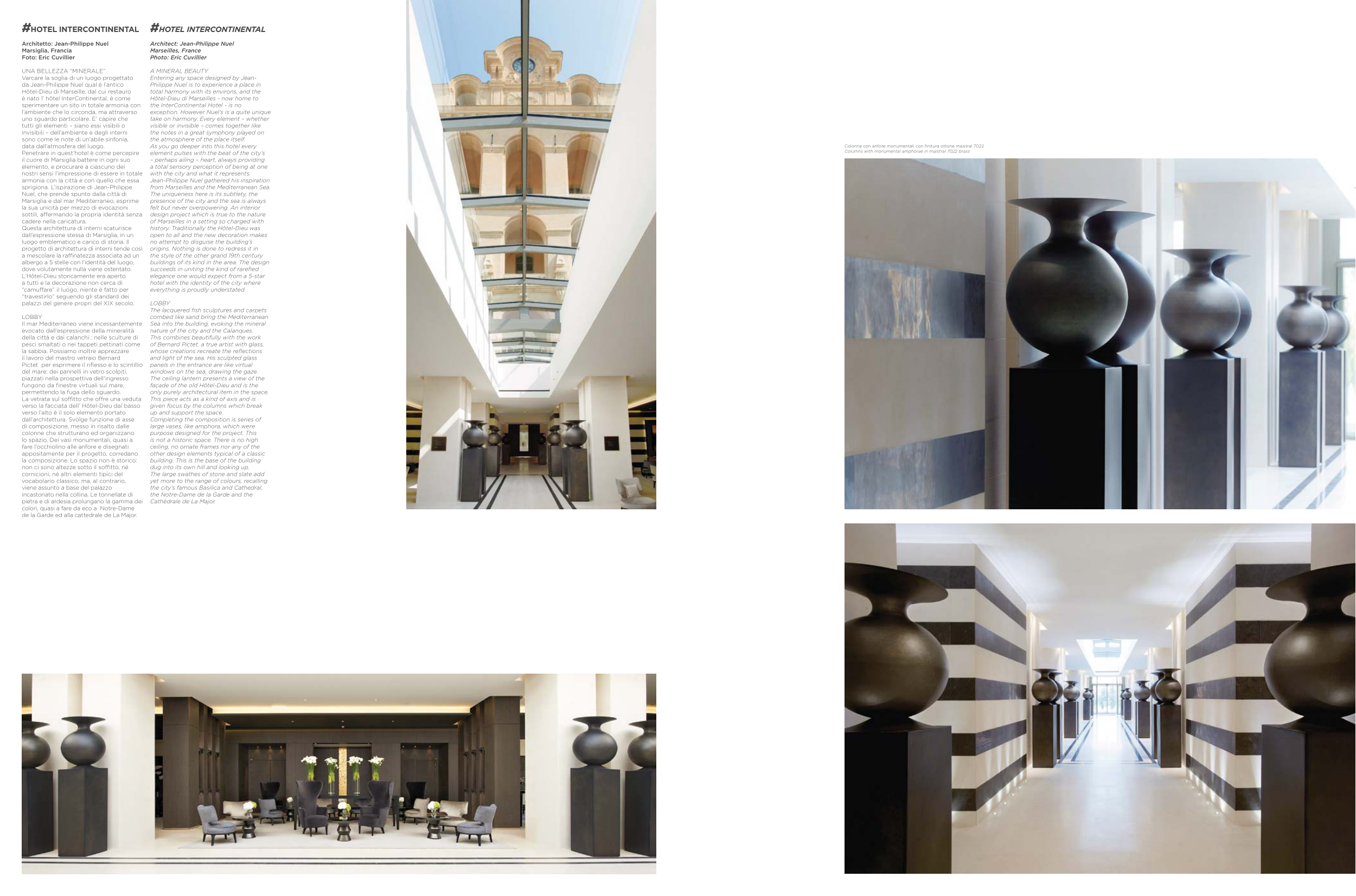#HOTEL INTERCONTINENTAL
Architect: Jean-Philippe Nuel
Marseilles, France
Photo: Eric Cuvillier
A MINERAL BEAUTY
Entering any space designed by Jean-
Philippe Nuel is to experience a place in
total harmony with its environs, and the
Hôtel-Dieu di Marseilles - now home to
the InterContinental Hotel - is no
exception. However Nuel’s is a quite unique
take on harmony. Every element – whether
visible or invisible – comes together like
the notes in a great symphony played on
the atmosphere of the place itself.
As you go deeper into this hotel every
element pulses with the beat of the city’s
– perhaps ailing – heart, always providing
a total sensory perception of being at one
with the city and what it represents.
Jean-Philippe Nuel gathered his inspiration
from Marseilles and the Mediterranean Sea.
The uniqueness here is its subtlety, the
presence of the city and the sea is always
felt but never overpowering. An interior
design project which is true to the nature
of Marseilles in a setting so charged with
history. Traditionally the Hôtel-Dieu was
open to all and the new decoration makes
no attempt to disguise the building’s
origins. Nothing is done to redress it in
the style of the other grand 19th century
buildings of its kind in the area. The design
succeeds in uniting the kind of rarefied
elegance one would expect from a 5-star
hotel with the identity of the city where
everything is proudly understated.
LOBBY
The lacquered fish sculptures and carpets
combed like sand bring the Mediterranean
Sea into the building, evoking the mineral
nature of the city and the Calanques.
This combines beautifully with the work
of Bernard Pictet, a true artist with glass,
whose creations recreate the reflections
and light of the sea. His sculpted glass
panels in the entrance are like virtual
windows on the sea, drawing the gaze.
The ceiling lantern presents a view of the
façade of the old Hôtel-Dieu and is the
only purely architectural item in the space.
This piece acts as a kind of axis and is
given focus by the columns which break
up and support the space.
Completing the composition is series of
large vases, like amphora, which were
purpose designed for the project. This
is not a historic space. There is no high
ceiling, no ornate frames nor any of the
other design elements typical of a classic
building. This is the base of the building
dug into its own hill and looking up.
The large swathes of stone and slate add
yet more to the range of colours, recalling
the city’s famous Basilica and Cathedral,
the Notre-Dame de la Garde and the
Cathèdrale de La Major.
#HOTEL INTERCONTINENTAL
Architetto: Jean-Philippe Nuel
Marsiglia, Francia
Foto: Eric Cuvillier
UNA BELLEZZA “MINERALE”
Varcare la soglia di un luogo progettato
da Jean-Philippe Nuel qual è l’antico
Hôtel-Dieu di Marseille, dal cui restauro
è nato l’ hôtel InterContinental, è come
sperimentare un sito in totale armonia con
l’ambiente che lo circonda, ma attraverso
uno sguardo particolare. E’ capire che
tutti gli elementi – siano essi visibili o
invisibili – dell’ambiente e degli interni
sono come le note di un’abile sinfonia,
data dall’atmosfera del luogo.
Penetrare in quest’hotel è come percepire
il cuore di Marsiglia battere in ogni suo
elemento, e procurare a ciascuno dei
nostri sensi l’impressione di essere in totale
armonia con la città e con quello che essa
sprigiona. L’ispirazione di Jean-Philippe
Nuel, che prende spunto dalla città di
Marsiglia e dal mar Mediterraneo, esprime
la sua unicità per mezzo di evocazioni
sottili, affermando la propria identità senza
cadere nella caricatura.
Questa architettura di interni scaturisce
dall’espressione stessa di Marsiglia, in un
luogo emblematico e carico di storia. Il
progetto di architettura di interni tende così
a mescolare la raffinatezza associata ad un
albergo a 5 stelle con l’identità del luogo,
dove volutamente nulla viene ostentato.
L’Hôtel-Dieu storicamente era aperto
a tutti e la decorazione non cerca di
“camuffare” il luogo, niente è fatto per
“travestirlo” seguendo gli standard dei
palazzi del genere propri del XIX secolo.
LOBBY
Il mar Mediterraneo viene incessantemente
evocato dall’espressione della mineralità
della città e dai calanchi : nelle sculture di
pesci smaltati o nei tappeti pettinati come
la sabbia. Possiamo inoltre apprezzare
il lavoro del mastro vetraio Bernard
Pictet per esprimere il riflesso e lo scintillio
del mare: dei pannelli in vetro scolpiti,
piazzati nella prospettiva dell’ingresso
fungono da finestre virtuali sul mare,
permettendo la fuga dello sguardo.
La vetrata sul soffitto che offre una veduta
verso la facciata dell’ Hôtel-Dieu dal basso
verso l’alto è il solo elemento portato
dall’architettura. Svolge funzione di asse
di composizione, messo in risalto dalle
colonne che strutturano ed organizzano
lo spazio. Dei vasi monumentali, quasi a
fare l’occhiolino alle anfore e disegnati
appositamente per il progetto, corredano
la composizione. Lo spazio non è storico:
non ci sono altezze sotto il soffitto, né
cornicioni, né altri elementi tipici del
vocabolario classico, ma, al contrario,
viene assunto a base del palazzo
incastonato nella collina. Le tonnellate di
pietra e di ardesia prolungano la gamma dei
colori, quasi a fare da eco a Notre-Dame
de la Garde ed alla cattedrale de La Major.
Colonne con anfore monumentali con finitura ottone maistral 7022
Columns with monumental amphorae in maistral 7022 brass


